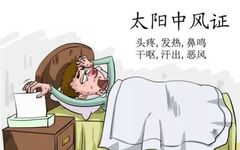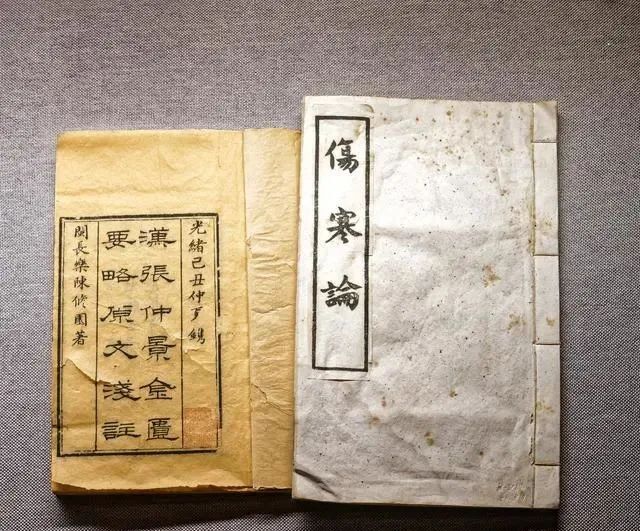
However, many people say that after reading the “Treatise on Cold Damage” for a long time, they ultimately feel it is useless, believing that its clinical effects are not as obvious as described in the book. This is mainly due to some people’s insufficient understanding of the “Treatise on Cold Damage,” leading to a misinterpretation of its principles. Today, I bring you an excerpt from the simplified version of the Treatise on Cold Damage, which is very simple and understandable even for those without a background in Traditional Chinese Medicine (TCM), and is worth collecting!1. The basic symptoms of Taiyang disease are floating pulse, headache, stiffness in the neck, and aversion to cold.2. Taiyang disease, characterized by fever, sweating, aversion to wind, headache, stiffness in the neck, and a floating and relaxed pulse, is called wind stroke.3. In Taiyang disease, if there is already fever or not yet fever, aversion to cold, headache, stiffness in the neck, body aches, nausea, no sweating, and the pulse at the cun, guan, and chi positions is all floating and tight, it is called cold damage.
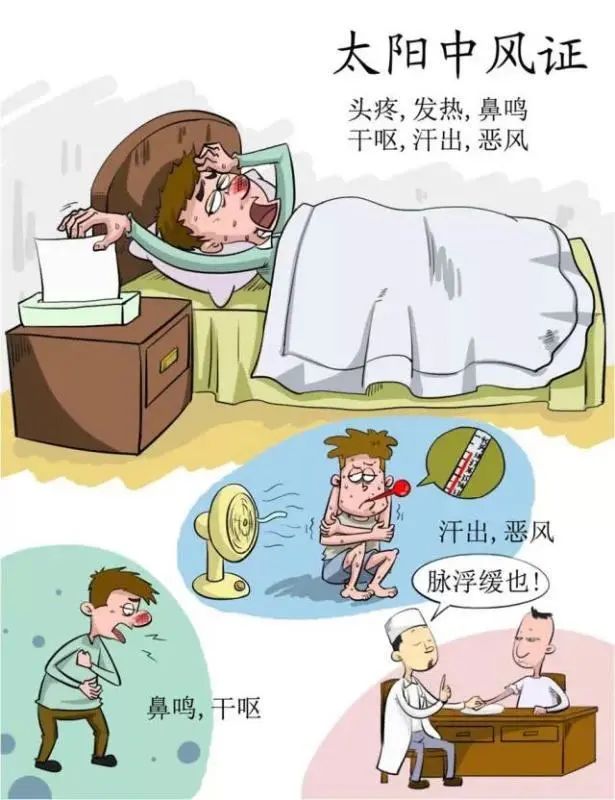
4. On the first day of an externally contracted disease, if the evil is in the Taiyang and the pulse and symptoms remain unchanged in the Taiyang, this indicates that the disease has not yet transformed. If the patient constantly feels nauseous, is restless, and has a rapid and urgent pulse, it indicates that the evil qi has transformed internally, showing that the disease has transformed.5. On the second or third day of an externally contracted disease, if the evil has transmitted to the Yangming or Shaoyang, and there are no Yangming or Shaoyang symptoms but only Taiyang symptoms, it indicates that the disease has not transformed.6. In Taiyang disease, if there is fever, thirst, and no aversion to cold, it is called warm disease. Warm disease is caused by the invasion of warm evil, so it is forbidden to use pungent and warm sweating, purging, or fire attack. If pungent and warm sweating is mistakenly used, it will exacerbate the heat, leading to body heat, a floating and strong pulse at the chi positions, spontaneous sweating, heaviness of the body, drowsiness, snoring during breathing, and difficulty speaking, which is called wind warmth. If purging is mistakenly used, it will damage the yin fluids, leading to scanty and obstructed urination, direct gaze, and incontinence of stool.If fire attack is mistakenly used, it will cause the evil heat to become more intense, leading to internal fire attack. Mild cases may cause yellowing of the skin, while severe cases may lead to convulsions of the hands and feet, resembling seizures, with deep yellow skin, as if scorched by smoke and fire. A single misdiagnosis may allow the patient to survive for a while, but repeated misdiagnosis will endanger the patient’s life.
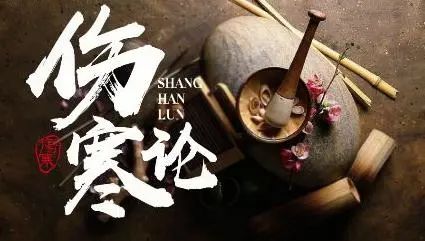
7. If a patient with an externally contracted disease exhibits symptoms of fever and aversion to cold, it indicates that the disease is in the Yang meridian; if there are no fever and aversion to cold, it indicates that the disease is in the Yin meridian. Those with disease in the Yang meridian can generally recover in about seven days; those with disease in the Yin meridian can generally recover in about six days. This is because seven belongs to the Yang number and six belongs to the Yin number.8. In Taiyang disease, if the headache lasts more than seven days and resolves on its own, it is because the evil qi has run its course in the Taiyang meridian. If the evil qi has not run its course and shows a tendency to transform into the Yangming meridian, acupuncture at the foot Yangming meridian points can help clear the meridian qi, enhance the anti-evil force, and prevent the evil qi from transmitting internally to the Yangming, leading to recovery.9. The time when Taiyang disease is about to resolve is mostly between 9 AM and 3 PM.10. Those who are prone to Taiyang wind stroke, after the exterior symptoms resolve, may still feel uncomfortable in the body and will need some time for the righteous qi to recover before they can fully heal.
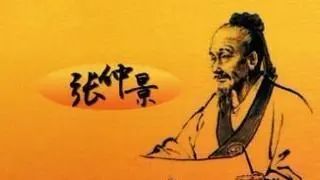
11. If the patient’s body feels hot but they want to wear many clothes, this is a manifestation of false heat externally and true cold internally; if the body feels cold but they do not want to wear clothes, this reflects false cold externally and true heat internally.12. In Taiyang wind stroke syndrome, the defensive Yang resists the evil and is floating and strong externally, while the nutritive Yin cannot guard internally and is weak. The floating and strong defensive Yang causes fever, while the weak nutritive Yin leads to spontaneous sweating. The patient feels cold and shivers, as if covered with fur, has nasal congestion and difficulty breathing, and dry retching, and should be treated with Guizhi Decoction.Guizhi Decoction FormulaGuizhi (Cinnamon Twig) 3 liang, Bai Shao (White Peony) 3 liang, Gan Cao (Licorice) 2 liang, Sheng Jiang (Fresh Ginger) 3 liang sliced, Da Zao (Jujube) 12 pieces split open. Crush the first three herbs and mix with the last two herbs, add 7 sheng of water, and simmer on low heat to reduce to 3 sheng. Remove the dregs, and when the decoction is at a suitable temperature, take 1 sheng, three times a day. After taking the medicine, drink a large bowl of hot thin porridge to assist the medicinal effect, and cover with a cotton quilt for about two hours to keep warm and promote sweating. The best degree of sweating is slight sweating all over; do not let the sweat flow like a stream, otherwise, it will harm Yang and consume Yin, and the disease will definitely not resolve. If after the first dose the sweat comes out and the disease resolves, stop taking the second and third doses; there is no need to finish the entire dose. If after the first dose there is no sweating, you can follow the above method to take the second dose. If after the second dose there is still no sweating, then the third dose can be taken appropriately earlier, about half a day to finish one dose. If the condition is severe, you can take the medicine day and night, closely observing for 24 hours. If after taking one dose the symptoms still persist, you can continue taking the medicine. If after taking the medicine there is still no sweating, then you can continue taking two or three doses. During the medication period, avoid eating raw, cold, sticky, greasy, garlic, mustard, coriander, dairy products, and spoiled or unpleasant-smelling foods.13. In Taiyang disease, as long as there are symptoms of headache, fever, sweating, and aversion to wind, Guizhi Decoction can be used for treatment.14. In Taiyang disease, if there is stiffness in the neck and back, and the patient cannot move freely, and there is sweating and aversion to wind, it is treated with Guizhi Jia Gegen Decoction.Guizhi Jia Gegen Decoction FormulaGegen (Kudzu Root) 4 liang, Bai Shao 3 liang, Sheng Jiang 3 liang sliced, Gan Cao 2 liang roasted, Da Zao 12 pieces split open, Guizhi 2 liang peeled. Use 10 sheng of water, first add Gegen and simmer to reduce by 2 sheng, remove the white foam, then add the other herbs, and simmer to 3 sheng, remove the dregs, and take 1 sheng warm each time. After taking the medicine, cover with a cotton quilt to keep warm and promote sweating, aiming for slight sweating all over. Other nursing methods and dietary restrictions are the same as for Guizhi Decoction.15. In Taiyang disease, if purgative medicine is mistakenly used, and the patient feels a sensation of qi rising in the chest, Guizhi Decoction can be used for treatment, following the same method as before. If after purging there is no sensation of qi rising, Guizhi Decoction should not be used for treatment.16. On the third day of Taiyang disease, if sweating methods, vomiting methods, purging methods, or warming needle methods have been used, and the condition still does not resolve, this indicates a bad disease, and Guizhi Decoction is no longer applicable. For bad diseases, a detailed examination of the pulse and symptoms should be conducted to understand what incorrect treatment was used and how the disease has evolved, and treatment should be based on the symptoms.Guizhi Decoction is originally a formula for resolving the exterior and nourishing the interior, suitable for Taiyang wind stroke syndrome. If the patient’s pulse is floating and tight, with fever and no sweating, it belongs to Taiyang cold damage syndrome, and Guizhi Decoction should not be used for treatment. Practitioners must always remember this point and must not make mistakes.17. For those who usually drink alcohol, if they suffer from Taiyang wind stroke syndrome, using Guizhi Decoction for treatment will lead to vomiting, as those who drink alcohol often have damp-heat retained internally, and Guizhi Decoction is a pungent and warm formula that will further promote heat and retain dampness.18. For patients with a history of asthma, if they suffer from Taiyang wind stroke syndrome, it is best to use Guizhi Decoction with Hou Po (Magnolia Bark) and Xing Ren (Apricot Kernel) for treatment.19. For any patient with internal heat, if they take Guizhi Decoction and experience vomiting, they may later develop symptoms of vomiting pus and blood.20. In Taiyang disease, excessive sweating leads to profuse sweating, the patient feels cold, urination is scanty, and the limbs feel slightly stiff and painful, with difficulty in flexing and extending. If headache, fever, and other exterior symptoms still exist, Guizhi Jia Fuzi Decoction should be used for treatment.Guizhi Jia Fuzi Decoction FormulaGuizhi 3 liang peeled, Bai Shao 3 liang, Gan Cao 3 liang roasted, Sheng Jiang 3 liang sliced, Da Zao 12 pieces split open, Fuzi 1 piece processed and peeled, broken into 8 pieces. Use 7 sheng of water, simmer to 3 sheng, remove the dregs, and take 1 sheng warm each time. The old version states: now use Guizhi Decoction and add Fuzi, with nursing methods the same as before.21. In Taiyang disease, if purgative medicine is mistakenly used, and the pulse is rapid and short, with a feeling of fullness in the chest, Guizhi Qu Shao Yao Decoction should be used for treatment.Guizhi Qu Shao Yao Decoction FormulaGuizhi 3 liang peeled, Gan Cao 2 liang roasted, Sheng Jiang 3 liang sliced, Da Zao 12 pieces split open, use 7 sheng of water, simmer to 3 sheng, remove the dregs, and take 1 sheng warm each time. The old version states: now use Guizhi Decoction and remove Shao Yao, with nursing methods the same as before.22. If after purging there is a feeling of fullness and tightness in the chest, with a rapid pulse, Guizhi Qu Shao Yao Jia Fuzi Decoction should be used for treatment.Guizhi Qu Shao Yao Jia Fuzi Decoction FormulaGuizhi 3 liang peeled, Gan Cao 2 liang roasted, Sheng Jiang 3 liang sliced, Da Zao 12 pieces split open, Fuzi 1 piece processed and peeled, broken into 8 pieces. Use 7 sheng of water, simmer to 3 sheng, remove the dregs, and take 1 sheng warm each time. The old version states: now use Guizhi Decoction, remove Shao Yao, and add Fuzi, with nursing methods the same as before.23. In Taiyang disease, if the patient has had the disease for eight or nine days, with fever and aversion to cold, the duration of fever is longer than that of aversion to cold, occurring two or three times a day, resembling malaria, and the patient does not vomit, with normal urination and bowel movements, this indicates that the evil qi is stagnating on the surface. At this time, if the pulse is gradually becoming even and gentle, it indicates that the evil qi is leaving and the righteous qi is recovering, and the disease will soon heal. If the pulse is weak and the patient feels cold, this indicates that both the exterior and interior Yang qi are deficient, which may be due to the mistaken use of sweating, vomiting, or purging, and therefore, sweating, purging, or vomiting methods should not be used for treatment. If the face appears red, it indicates that the evil qi is still stagnating on the surface and the patient’s skin may still have itching symptoms, suitable for treatment with Guizhi Mahuang Decoction.Guizhi Mahuang Decoction FormulaGuizhi 1 liang 16 zhu peeled, Bai Shao, Sheng Jiang sliced, Gan Cao roasted, Mahuang 1 liang 16 zhu removed from the nodes, Da Zao 4 pieces split open, Xing Ren 24 pieces, use 5 sheng of water, first add Mahuang and simmer, remove the white foam, then add the other herbs, simmer to 1 sheng 8 he, remove the dregs, take 1 sheng warm each time. The old version states: take 3 he of Guizhi Decoction, 3 he of Mahuang Decoction, combine to make 6 he, take all at once. Nursing methods the same as before.24. In Taiyang disease, as long as there are symptoms of headache, fever, sweating, and aversion to wind, Guizhi Decoction can be used for treatment.25. In Taiyang disease, if there is stiffness in the neck and back, and the patient cannot move freely, and there is sweating and aversion to wind, it is treated with Guizhi Jia Gegen Decoction.Guizhi Jia Gegen Decoction FormulaGegen 4 liang, Bai Shao 3 liang, Sheng Jiang 3 liang sliced, Gan Cao 2 liang roasted, Da Zao 12 pieces split open, Guizhi 2 liang peeled. Use 10 sheng of water, first add Gegen and simmer to reduce by 2 sheng, remove the white foam, then add the other herbs, and simmer to 3 sheng, remove the dregs, and take 1 sheng warm each time. After taking the medicine, cover with a cotton quilt to keep warm and promote sweating, aiming for slight sweating all over. Other nursing methods and dietary restrictions are the same as for Guizhi Decoction.26. In Taiyang disease, if purgative medicine is mistakenly used, and the pulse is rapid and short, with a feeling of fullness in the chest, Guizhi Qu Shao Yao Decoction should be used for treatment.Guizhi Qu Shao Yao Decoction FormulaGuizhi 3 liang peeled, Gan Cao 2 liang roasted, Sheng Jiang 3 liang sliced, Da Zao 12 pieces split open, use 7 sheng of water, simmer to 3 sheng, remove the dregs, and take 1 sheng warm each time. The old version states: now use Guizhi Decoction and remove Shao Yao, with nursing methods the same as before.27. If after purging there is a feeling of fullness and tightness in the chest, with a rapid pulse, Guizhi Qu Shao Yao Jia Fuzi Decoction should be used for treatment.Guizhi Qu Shao Yao Jia Fuzi Decoction FormulaGuizhi 3 liang peeled, Gan Cao 2 liang roasted, Sheng Jiang 3 liang sliced, Da Zao 12 pieces split open, Fuzi 1 piece processed and peeled, broken into 8 pieces. Use 7 sheng of water, simmer to 3 sheng, remove the dregs, and take 1 sheng warm each time. The old version states: now use Guizhi Decoction, remove Shao Yao, and add Fuzi, with nursing methods the same as before.28. In Taiyang disease, if the patient has had the disease for eight or nine days, with fever and aversion to cold, the duration of fever is longer than that of aversion to cold, occurring two or three times a day, resembling malaria, and the patient does not vomit, with normal urination and bowel movements, this indicates that the evil qi is stagnating on the surface. At this time, if the pulse is gradually becoming even and gentle, it indicates that the evil qi is leaving and the righteous qi is recovering, and the disease will soon heal. If the pulse is weak and the patient feels cold, this indicates that both the exterior and interior Yang qi are deficient, which may be due to the mistaken use of sweating, vomiting, or purging, and therefore, sweating, purging, or vomiting methods should not be used for treatment. If the face appears red, it indicates that the evil qi is still stagnating on the surface and the patient’s skin may still have itching symptoms, suitable for treatment with Guizhi Mahuang Decoction.Guizhi Mahuang Decoction FormulaGuizhi 1 liang 16 zhu peeled, Bai Shao, Sheng Jiang sliced, Gan Cao roasted, Mahuang 1 liang 16 zhu removed from the nodes, Da Zao 4 pieces split open, Xing Ren 24 pieces, use 5 sheng of water, first add Mahuang and simmer, remove the white foam, then add the other herbs, simmer to 1 sheng 8 he, remove the dregs, take 1 sheng warm each time. The old version states: take 3 he of Guizhi Decoction, 3 he of Mahuang Decoction, combine to make 6 he, take all at once. Nursing methods the same as before.179. The symptoms of the disease are similar to those of Guizhi Decoction syndrome, but the pulse is not tight and the patient feels thirsty, indicating a warm disease rather than a Taiyang cold damage syndrome. If fire attack is mistakenly used, it will definitely lead to symptoms such as confusion.180. The main pathological features of Yangming disease are dryness and heat in the stomach and intestines.181. Yangming disease is caused by excessive sweating or mistaken purging or diuretic methods that damage the fluids, leading to dryness in the stomach and intestines, and the evil qi then transmits to Yangming, resulting in constipation and difficulty in bowel movements.182. The external symptoms of Yangming disease include fever, spontaneous sweating, and aversion to cold, but fear of heat.183. In the early stages of Yangming disease, if the patient feels cold but does not have a fever, this will stop on its own, followed by spontaneous sweating and fear of heat.184. The reason for the cessation of cold sensitivity is that Yangming is located centrally and belongs to the earth, just as all things return to the earth. The evil of the six meridians can transmit to Yangming and rarely to other meridians, while Yangming governs dryness and heat, and the evil transmitted to Yangming will quickly manifest as dryness and heat. Therefore, although there may be a brief period of cold sensitivity at the onset of Yangming disease, it will stop on its own the next day, which is a characteristic of Yangming disease.185. Originally belonging to Taiyang disease, if sweating methods are used at the onset, and the sweating is not thorough, it will lead to the evil qi transmitting to Yangming. In externally contracted diseases, symptoms such as fever without sweating, vomiting, and inability to eat indicate excessive heat from the cold damage evil, while continuous sweating indicates the transmission of evil to Yangming.186. On the third day of externally contracted disease, the pulse of Yangming disease is large.187. In externally contracted disease, if the pulse is floating and weak, the hands and feet are warm, this indicates that the disease belongs to Taiyin. Taiyin cold dampness is retained internally, and if the urination is smooth, there will be no yellowing of the skin; by the seventh or eighth day, if the bowel movements are hard, it indicates that the dampness has transformed into dryness, and it has turned into Yangming disease.188. In externally contracted disease, if the evil qi transmits to Yangming, the patient will exhibit continuous sweating.189. Yangming disease, if it receives wind evil, will show symptoms of bitter mouth, dry throat, abdominal fullness, slight shortness of breath, fever, and aversion to cold, with a tight pulse, and should not be purged. If purging is mistakenly used, it will exacerbate abdominal fullness and make urination difficult.190. Yangming disease, if the patient can eat, indicates that there is heat in the stomach, and they can digest food, which is called wind; if they cannot eat, it indicates that there is cold in the stomach, and they cannot digest food, which is called cold.191. Yangming cold syndrome, if the patient cannot eat, has difficulty urinating, and experiences continuous sweating in the hands and feet, this is a sign of impending solid masses, and the bowel movements will initially be hard, followed by loose stools. This is because the stomach is cold and cannot separate the water and grains.192. In Yangming disease, if the patient initially wants to eat, has difficulty urinating, and normal bowel movements, with joint pain and a sensation of heat as if covered with fur, suddenly becoming delirious, this indicates that water and dampness are stagnating on the surface. If the patient sweats freely and the disease resolves, it indicates that the righteous qi is overcoming the evil, and the evil is dispelled with the sweat. If the pulse is tight, the disease will heal.193. The time when Yangming disease is about to resolve is mostly between 3 PM and 9 PM.194. In Yangming cold syndrome, if the patient cannot eat and experiences difficulty urinating, and continuous sweating, this is a sign of impending solid masses, and the bowel movements will initially be hard, followed by loose stools. This is because the stomach is cold and cannot separate the water and grains.195. In Yangming disease, if the pulse is slow, the patient cannot eat enough, and if they overeat, they will feel slightly anxious, dizzy, and have difficulty urinating, with abdominal fullness, this indicates that solid masses are about to form. If purgative methods are used for treatment, and the abdominal fullness does not decrease, it is because the patient has a slow pulse, indicating cold, and the symptoms belong to cold dampness retained internally, so purging will be ineffective.196. In Yangming disease, if there should be much sweating but there is none, and the patient has a dry mouth and is thirsty, this indicates that the disease is Yangming cold syndrome. If the disease lasts for two or three days, with vomiting, coughing, and cold hands and feet, it indicates that the cold evil is rising, and there will definitely be a headache; if there is no cough or vomiting, and the hands and feet are not cold, the cold evil will not rise, and there will be no headache.197. In Yangming disease, if the head feels dizzy and the patient does not fear the cold, this indicates that it is Yangming wind syndrome, so they can eat. If there is coughing, the heat evil will rise, and the patient will definitely have a sore throat; if there is no cough, the heat evil will not rise, and the throat will not be sore.198. In Yangming disease, if there is no sweating, difficulty urinating, and extreme anxiety, this indicates that there is internal damp-heat retained in Yangming, and the skin will definitely turn yellow.199. In Yangming disease, if fire methods are mistakenly used, the fire evil will rise, and there will be slight sweating and difficulty urinating, leading to yellowing of the skin.· The End · Warm Reminder:This platform shares health-related graphic information for reference and learning purposes only and is not intended as a basis for medical diagnosis. If needed, please use under the guidance of a physician.⊙ Copyright Statement: The article is sourced from the internet; if there is any infringement, please contact us for removal.

It is most incredible that you have not clicked “Looking

